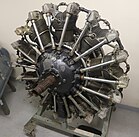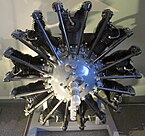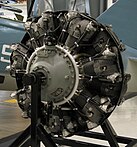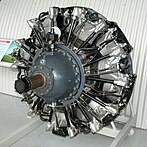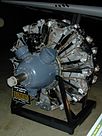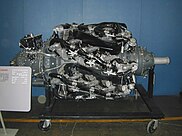Pratt & Whitney Wasp series
| Wasp series | |
|---|---|
| R-985, R-1340, R-1535, R-1830, R-2800 and R-4360 | |
| Type | Radial engine |
| National origin | United States |
| Manufacturer | Pratt & Whitney |
The Pratt & Whitney Wasp was the civilian name of a family of air-cooled radial piston engines developed in the 1920s, 1930s and 1940s.[1]
The Pratt & Whitney Aircraft Company (P&W) was founded in 1925 by Frederick B. Rentschler, who had previously been the President of Wright Aeronautical. He brought with him some of Wright's best designers and the new team quickly came up with their first design, the R-1340 Wasp.[1][2] The name "Wasp" was suggested for the first model by Rentschler's wife, Faye.[3][4]
Wasp series[edit]
R-985 Wasp Junior (1930)[5][6]
- 9-cylinder single row air cooled radial
- Bore x stroke: 5+3⁄16 in × 5+3⁄16 in (132 mm × 132 mm)
- Displacement: 985 cu in (16.14 L)
R-1340 Wasp (1925)[7][8]
- 9-cylinder single row air cooled radial
- Bore x stroke: 5+3⁄4 in × 5+3⁄4 in (146 mm × 146 mm)
- Displacement: 1,344 cu in (22.02 L)
R-1535 Twin Wasp Junior (1931)[9]
- 14-cylinder, two row, air cooled radial
- Bore x stroke: 5+3⁄16 in × 5+3⁄16 in (132 mm × 132 mm)
- Displacement: 1,535 cu in (25.15 L)
R-1830 Twin Wasp (1931)[10]
- 14-cylinder two row air cooled radial
- Bore x stroke: 5+1⁄2 in × 5+1⁄2 in (140 mm × 140 mm)
- Displacement: 1,830 cu in (30.0 L)
- 14-cylinder two row air cooled radial,
- Bore x stroke: 5+3⁄4 in × 5+1⁄2 in (146 mm × 140 mm)
- Displacement: 2,000 cu in (33 L)
- 14-cylinder two row air cooled radial
- Bore x stroke: 5+3⁄4 in × 6 in (146 mm × 152 mm)
- Displacement: 2,180 cu in (35.7 L)
R-2800 Double Wasp (1940)[5][13]
- 18-cylinder two row air cooled radial
- Bore x stroke: 5+3⁄4 in × 6 in (146 mm × 152 mm)
- Displacement: 2,804 cu in (45.95 L)
R-4360 Wasp Major (1942)[12][14]
- 28-cylinder four row air cooled radial
- Bore x stroke: 5+3⁄4 in × 6 in (146 mm × 152 mm)
- Displacement: 4,363 cu in (71.50 L)
Note: the designations refer to the engine configurations as follows: "R" = Radial, followed by the approximate displacement in cubic inches.
See also[edit]
Related development
Comparable engines
Related lists
References[edit]
Notes[edit]
- ^ a b Gunston 1986, pp. 109–113.
- ^ White 1995, pp. 195–198.
- ^ The Pratt & Whitney Aircraft Story 1950, p. 41.
- ^ Sullivan 2008, p. 8.
- ^ a b Gunston 1986, p. 111.
- ^ White 1995, p. 201.
- ^ Gunston 1986, p. 110.
- ^ White 1995, p. 195.
- ^ White 1995, p. 203.
- ^ White 1995, p. 206.
- ^ White 1995, p. 221.
- ^ a b Gunston 1986, p. 113.
- ^ White 1995, p. 222.
- ^ White 1995, p. 253.
Bibliography[edit]
- Gunston, Bill (1986). World Encyclopedia of Aero Engines. Wellingborough, Northamptonshire: Patrick Stephens Limited. ISBN 0-85059-717-X.
- Sullivan, Mark P. (2008). Dependable Engines: The Story of Pratt & Whitney. Reston, Virginia: American Institute of Aeronautics and Astronautics, Inc. ISBN 978-1-56347-957-1.
- The Pratt & Whitney Aircraft Story. East Hartford, Connecticut: Pratt & Whitney Aircraft. 1950.
- White, Graham (1995). Allied Aircraft Piston Engines of World War II. Warrendale, Pennsylvania: Society of Automotive Engineers, Inc. ISBN 1-56091-655-9.

